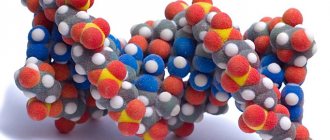The food pyramid helps organize a person’s nutrition in such a way that he can not only get rid of excess subcutaneous fat, but also normalize the functioning of the body’s internal systems. Nutritionists select a specific type of food pyramid taking into account the patient’s age, the characteristics of his physical condition (pregnancy, lactation) and the presence of health contraindications.
By following the main steps of a correctly individually designed scheme, a person will be able to achieve visible results in transformation without setting strict limits for himself in nutrition and usual lifestyle.
What is the food pyramid?
The food pyramid is a development of American nutritionists, which was first used in 1992 after the publication of information about it by the US Department of Agriculture. The diet plan under consideration illustrates the basic principles of proper nutrition.
Foods located at the base of the schematic pyramid should make up the majority of a person's daily menu, while the amount of food located at the top should be kept to a minimum.
The food pyramid is designed so that foods at the base need to be consumed in large quantities, and the top part is reduced to a minimum.
Despite the fact that a number of countries, including Russia, still do not have their own official nutrition pyramids, qualified specialists from the Research Institute of Nutrition of the Russian Academy of Medical Sciences adapt the basic idea of American scientists to the national characteristics of the inhabitants of their country.
Diversity of the healthy human food pyramid
The basic principles of the food pyramid of a healthy person were selected by nutritionists in order to make proper nutrition as varied as possible.
The ability to consume various types of foods that do not cause allergies and other acute reactions of the body allows the person losing weight to maintain a morally comfortable state, which contributes to longer compliance with the rules in the preparation of the diet.
All permitted products are grouped by color:
| Subgroup color | Description of the subgroup |
| Orange | Products included in the orange subgroup are cereals. They enrich the body with vitamins, minerals, fiber and vegetable protein. |
| Green | Includes all permitted vegetables except red ones. The recommended number of servings is from 3 to 5 per day. |
| Red | Includes fruits and red vegetables. Saturates the body with plant fiber, beta-carotene, vitamin C, folic acid, and microelements. |
| Yellow | Includes sources of vegetable fats. The volume of consumed products from this subgroup should be minimal. Otherwise, a person’s risk of developing cardiovascular diseases increases sharply. |
| Blue | The subgroup consists of dairy products that saturate the body with lactobacilli, bifidobacteria and animal proteins. |
| Violet | The purple step of the food pyramid consists of sources of plant and animal proteins. It is not recommended to consume semi-finished products and products made from meat by-products. |
“Harvard” Healthy Food Plate
British scientists from the Harvard School of Public Health have combined all these recommendations in their version of a healthy eating plate, which, in essence, repeats the above recommendations and sets priorities and proportions - what and in what proportions your diet should consist of .
The nutrition rules are simple:
1/4 plate: healthy proteins.
Give preference to: fish, poultry, seafood, legumes, nuts (but here is an important addition from Zozhnik - nuts are very high in calories, in addition they contain phytic acid - they should be consumed in moderation).
Limit: cheese, red meat.
Avoid: Processed meats - hot dogs, sausage, bacon, carbs, ham, etc.
1/4 plate: complex carbs/whole grains
Give preference to: any cereals - oatmeal, buckwheat, quinoa, brown rice, durum wheat pasta, whole grain bread and other complex carbohydrates.
Limit: refined grain products, white bread, white rice, sweet pastries.
Avoid: Sugary drinks (soda, soft drinks, etc.)
1/2 plate: vegetables + fruits
This is usually the weakest point: about half of your plate should be vegetables and fruits.
Most of this proportion should be given to non-starchy vegetables (that is, do not fill your entire vegetable allowance with potatoes). It is advisable to use a variety of vegetables, for example, different colors. Eat cabbage, cucumbers, tomatoes, pumpkin, sweet peppers, apples, carrots, greens, and onions.
Healthy vegetable oils - in moderation . Recommended vegetable oils: olive, rapeseed, corn and others. Zozhnik adds on his own: it is advisable to include flaxseed (it has the largest proportion of omega-3).
Avoid: Partially hydrogenated oils, which may contain harmful trans fats.
*Remember that reduced fat does not always mean “healthy.”
Drink water, coffee or tea . Avoid sugary drinks, limit milk and dairy products to 1-2 glasses per day, and limit juice consumption to a small glass per day.
Harvard recommends sticking these nutritional rules on your refrigerator so that you remember them for the rest of your life. And we want to help you with this.
steps
The food pyramid consists of 4 main steps.
Base
The base of the food pyramid is made up of the 3 largest food groups.
Nutritionists recommend including them in your diet daily or every other day:
- sources of complex carbohydrates (this subgroup includes whole grain products, which provide the body with useful microelements that improve the functioning of internal organs and strengthen the immune system);
- vegetables and fruits in any form of consumption (these products saturate the body with the necessary amount of fiber. Vegetables and fruits also reduce the rate of food absorption, which ensures complete digestion of healthy protein foods);
- unsaturated vegetable fats (this category includes the most useful varieties of vegetable oils extracted from corn, sunflowers, flax and olives. Vegetable fats not only reduce the concentration of harmful cholesterol in human blood, but also contribute to the rapid restoration of muscle fibers, which is especially necessary for athletes, practicing strength training).
Vitamin and mineral level
The vitamin and mineral stage of the food pyramid is formed by:
- low fat milk;
- cottage cheese no more than 1-3% fat content;
- low fat yogurt;
- cheese (preferably curd or hard varieties);
- kefir with low fat content.
It is necessary to consume dairy and fermented milk products, since they are the main source of complete animal proteins. If there are allergic reactions to the composition of milk and its industrial products, the classic cow drink is replaced with soy, coconut and almond.
Protein stage
The protein stage of the food pyramid consists of products of various origins.
They are divided into main groups:
- vegetable (for example, cereals, legumes, mushrooms, etc. They saturate the body with proteins and dietary fiber, normalizing the functioning of the gastrointestinal tract);
- animals (for example, dietary meat, white fish, chicken, turkey, seafood, etc. Products included in this subgroup are the main suppliers of amino acids necessary for the normal functioning of the body).
Dishes that include products related to protein sources must be consumed daily in quantities of no more than 50-100 g per day (in the absence of special recommendations from a doctor who has an understanding of the health of a particular person).
Vertex
At the very top of the food pyramid are foods whose consumption should be minimized not only by people trying to lose weight, but also by those who care about their health.
They are:
- potatoes and dishes containing them (due to the large amount of starch in their composition, potatoes are not recommended for use in the diet of those losing weight, as well as those who have gastrointestinal dysfunction);
- animal fats;
- fast carbohydrates (they are not only in the absolute majority deposited in the fat layer, but also affect level fluctuations);
- products with a high content of refined sugar;
- baking from regular wheat flour (as an alternative, it is permissible to use whole grain rye flour or unleavened dough with corn or flaxseed flour);
- alcoholic drinks.
CHILDHOOD GUIDE
Didactic manual
"Food Pyramid"
for children of senior preschool age
Kuzina Elena Gennadievna,
teacher of MBDOU No. 103,
Nizhny Novgorod
Goal: developing a healthy lifestyle by studying the principles of proper nutrition.
Tasks:
- form the right attitude towards your health through the concept of healthy eating;
- teach how to choose healthy and safe food products and create a menu;
- to form the basis of rational nutrition in children.
The game is designed taking into account the age characteristics of children of senior preschool age. Using this game, you can give children tasks of varying difficulty. The game develops logical thinking in children, develops memory, expands vocabulary, contributes to the education of the basics of children's nutritional culture and the desire to lead a healthy lifestyle. Children can play this game either together with adults or alone.
The didactic manual is a tetrahedral pyramid, on each side of which there are different tasks on proper nutrition. On the first side, you need to create a menu for the day: breakfast, lunch, dinner (children insert pictures depicting various products into their pockets). On the second side are “Lullia” circles about healthy products. On the third side, children correlate vitamins with foods that contain them. On the fourth side, children divide foods into three groups according to their content: proteins, fats, carbohydrates.
This didactic manual allows you to expand children's knowledge about proper nutrition, and also promotes a healthy lifestyle.
I propose one of the options for working with this manual: conversation “Secrets of healthy eating”
Progress of the conversation:
-What do you guys think, what does it mean to lead a healthy lifestyle? (Children's answers).
-Guys, “Healthy lifestyle” includes several components. And one of them is very important – healthy eating. But is all the food we eat equally healthy? What foods should you choose to maintain your health for many years? We will talk about this today “Secrets of healthy eating”
Proverb: “We are what we eat.”
-How do you understand these words?
-Our health depends entirely on what we eat.
What is healthy eating? Demonstrating the guide “Food Pyramid”
- Varied food.
-How do you understand this?
-Different foods contain different nutrients and vitamins. You can’t eat the same thing all the time, you need to eat different foods.
- Complete nutrition.
-How do you understand this?
- A complete or balanced diet is a sufficient amount of proteins, fats, carbohydrates, vitamins, and minerals.
Proteins are the most important component of food. The basic life processes in the body depend on them: metabolism, the ability to grow, reproduce, and think.
Not all proteins are created equal. Combinations of plant and dairy products are favorable, for example, a combination of a piece of bread and a glass of milk, flour products with cottage cheese, flour dishes with meat. Fish is healthy, dairy products, butter, and nuts are very healthy.
These products help build the body and strengthen bones. It is these products that supply cells with building material for growth.
Other foods give the body energy. To move, to think well, not to get tired. These foods contain carbohydrates. These are: buckwheat, honey, oatmeal, raisins, butter, bread. The main energy carbohydrate is glucose, so it should be a necessary component of food. Nerve cells and brain cells operate only on glucose. You need to eat a lot of vegetables and fruits.
There is also another energy resource - fats. The heart, for example, uses fat almost exclusively for fuel. Dietary fats are true energy concentrates. The complete exclusion of fats from the diet leads to serious health problems; their deficiency leads to a delay in the development of a growing organism, inflammation of the skin, but excess fat leads to an increase in cholesterol levels in the blood. In this case, the condition of the blood vessels worsens.
An essential component of a healthy diet are vitamins and minerals.
-Which foods contain vitamins and minerals help the body grow and be healthy. Fruits and vegetables are real storehouses of vitamins necessary for humans. If your body has a lot of vitamins, it will easily defeat any disease, and you will have a good mood and excellent health.
- Healthy diet.
-How do you understand this?
-Healthy nutrition – first of all natural. Therefore, of course, preference should be given to food without preservatives (whole bread, cereals, meat, fish).
Food must contain vitamins! Fresh vegetables and fruits, honey, dried apricots, nuts, raisins, buckwheat, oatmeal, millet - these are products that increase the vital activity of the body. You need to include them in your diet! These are the most useful products!!!
-We have with you the “Healthy Eating Pyramid”.
(Working with the healthy eating pyramid.)
The cards contain the names of food products.
Food : cereals, fruits, vegetables, wholemeal bread, fish, meat, milk, candy, sugar, butter, cheese, eggs, sausage, cake, chips, lemonade, salt, nuts, etc.
You need to distribute them among the floors of the pyramid:
on the 1st floor - fats - the healthiest foods;
on the 2nd floor there are squirrels. they need to be consumed in smaller quantities;
on the 3rd floor - carbohydrates - foods whose consumption should be limited or not consumed at all;
Well done!
I wish you to bloom and grow
Save money, improve your health,
It is for a long journey -
The most important condition!
Formation of primary ideas about the values of a healthy lifestyle in preschool children Educational books for young children on a healthy lifestyle Healthy lifestyle Formation of a healthy lifestyle in preschool children in the process of physical education and educational activities >
Other principles of the healthy eating pyramid. Effectiveness conditions
The food pyramid of nutrition, in addition to the principle of diversity, is also based on:
- the principle of proportionality (the essence of the principle is the need to maintain clear proportions when combining foods from the nutrition pyramid into one meal);
- the principle of individuality (despite the universality and generality of the food pyramid, a specific nutritional plan should be drawn up for each person individually, taking into account the characteristics of his body and age);
- the principle of moderation (proper nutrition is possible only if you observe moderation in the consumption of healthy food. With proper organization of the daily menu, a person will not feel acute hunger or heaviness in the stomach from overeating during the day);
- the principle of physical activity (in order to maintain the normal functioning of the internal systems of the body and organs, it is necessary to engage in any sport at least 3 times a week. If it is not possible to attend specialized classes, it is recommended to count the number of steps taken during the day. It should be at least 8 thousand. ).
The basis of the food pyramid
It is recommended that you familiarize yourself with the principles of the food pyramid, which will teach you how to eat properly. First of all, you need to eat a lot of green leafy vegetables. They contain antioxidants and are low in calories. Vegetables contain fiber, which helps fight pathologies and reduces cholesterol levels. Antioxidant deficiencies have been linked to heart disease, eye disease and memory loss.
Saturated fat intake should be limited to one serving per day for whole dairy products. Red meat is allowed to be consumed no more than three times a week. Trans fats should be completely eliminated.
To maintain proper nutrition, you should also eliminate white potatoes, rice, bread, pastries and cereals. Choose whole wheat pasta, brown rice and barley. They charge you with energy for a long time, reduce the risk of heart pathologies and diabetes.
It is recommended to consume multivitamins to reduce the risk of developing colon cancer. Women who take vitamin supplements are known to look younger than their age. Students should take multivitamins to improve cognitive function.
Types of food pyramids
The original version of the food pyramid created by the Americans was modified many times to suit the largest number of people seeking to normalize their lifestyle.
MyPyramid
MyPyramid was structured in 2007.
This is the most widely used type of food pyramid, involving the classification of food products into color groups:
- cereals;
- green vegetables;
- red vegetables and fruits;
- sources of fats;
- milk products;
- proteins of various origins.
Its standard schematic representation assumes the presence of a silhouette of a person climbing the steps. This detail emphasizes the recommendation of nutritionists to maintain a normal level of physical activity while improving nutrition.
In order not to create a stressful situation for the body, due to which the amount of fat mass will begin to actively increase, you should switch to proper nutrition gradually (for example, you can start by reducing the amount of sugar consumed).
Harvard
The food pyramid, developed by Harvard nutritionist Walter Willett, is discussed in more detail in its creator's book.
The scientist’s main recommendations, schematically depicted in the pyramid, are:
- strict weight control and constant maintenance at a normal level;
- exclusion of saturated fats from the diet and their subsequent replacement with unsaturated fats;
- consumption of the maximum amount of whole grains;
- use nuts, legumes, white fish and poultry as the main suppliers of protein to the body;
- consume vegetables and fruits daily (preferably seasonal);
- give up bad habits (alcohol and smoking);
- supplement your diet with vitamin and mineral complexes selected by a nutritionist individually for a person, taking into account the needs of his body.
Simplified
The simplified food pyramid has a second name - the Asian scheme. It involves a complete rejection of meat, dairy, flour products, as well as dishes with a high sugar content and pronounced flavorings.
The basis of the diet in this case is formed by:
- any vegetables;
- steamed rice;
- soy products;
- green tea or matcha (“green coffee”).
For children
The food pyramid intended for children is visually identical to its adult counterpart (classic color scheme). The only difference is the number and width of its constituent segments. The fundamental group in this case is the one that contains dairy and fermented milk products.
For children under 3-4 years of age, the vitamins supplied by products in this segment are necessary for the proper development of the skeletal, nervous and cardiovascular systems. In second place in terms of segment width in the children's pyramid are the meat and fish subgroups.
No less important is the group of cereals, which are recommended to be consumed in the form of boiled porridge. The next segment of the children's food pyramid is chicken or quail eggs. It is recommended to use dried fruits, natural marmalade and honey (separate segment) as a source of healthy sugar in baby food.
For pregnant
The pyramid for pregnant women is compiled only individually. It is especially important to resort to adjusting the diet in case of acute lack of vitamins and minerals in the body of the expectant mother.
Organizing your eating habits will not only improve the woman’s actual condition, reduce risks during pregnancy and support the correct formation of the child’s body systems, but will also prevent the pregnant woman from gaining fat, which will be difficult to get rid of after childbirth.
For vegetarians
The vegetarian food pyramid is a nutritional pattern based on the consumption of plant foods. It implies a complete rejection of meat, dairy products (replaced with soy products), eggs and fish (regardless of the type of product). All dishes consumed by a vegetarian should include cereals and legumes, fresh vegetables and fruits.
It is highly not recommended to suddenly switch to the style of nutrition in question from a complete diet. Such stress for the body can not only negatively affect a person’s appearance (weight will begin to increase), but also on the functioning of the body’s internal systems (for example, constipation will appear or a person will begin to feel nauseated during the day).
The Harvard Healthy Eating Pyramid is a long-term strategy based on scientific evidence.
When it comes to nutrition, it is difficult to determine what is healthy and what is harmful . The food industry spends billions of dollars every year to influence our choices, and the media feeds us with all kinds of news from the world of nutrition almost daily. a reliable source on which to rely in this matter arises I want to talk about a book that became such a source for me. may be the most useful book I've read this year. Approximate post size? 7 pages. The book “Eat, Drink, and Be Healthy: The Harvard Medical School Guide to Healthy Eating” (in Russian translation - “Eat, Drink - and Be Healthy”) was written by the famous nutritionist, Professor Walter Willett from Harvard Medical School.
Dr. Willett is at the helm of the largest dietary cohort studies examining the long-term impact of diet on disease.
The scale of the research is impressive; for example, data on the diet of more than 100,000 people has been collected and analyzed over several decades.
The results of such studies and the conclusions drawn from them formed the basis of the so-called Harvard Healthy Eating Pyramid.
As is clear from the picture (I apologize for the quality of the scan), this pyramid recommends including in the diet the maximum amount of foods located at its base and lower tiers, and reducing the number of foods at the top.
The 11 chapters of this book detail the scientific evidence on which the pyramid was built.
Key features of the Harvard Healthy Eating Pyramid:
- regular monitoring and maintenance of normal weight;
- replacing saturated and trans fats in the diet with unsaturated (healthy) fats;
- replacing processed grains with whole grains;
- eating healthier sources of protein: nuts, legumes, poultry and fish;
- an abundance of fruits and vegetables in the diet;
- moderate alcohol consumption;
- taking a daily multivitamin.
A separate chapter of the book is devoted to an analysis of the strengths and weaknesses of the most popular diets, such as the Atkins system or the low-fat diet.
The main conclusion: all diets give a short-term effect, while the main goal should be to create a healthy diet that will help keep your weight under control for many years. The Harvard Pyramid represents the optimal long-term strategy for healthy eating. Its goal is to encourage you to eat familiar foods that research shows promotes health and reduces the risk of chronic disease.
Below I offer a selection of the main points from this book. Perhaps some of them will surprise you.
Key ideas of the book
Normal weight
- The numbers that the scale shows you are the second most important factor (after smoking) that determines your health.
- Maintaining a healthy weight is much more important for long-term health than the amount of antioxidants in your diet or the exact ratio of fats to carbohydrates.
- Body mass index (BMI) (an indicator that takes into account the ratio of height and weight) will help you determine your normal weight.
- If you consume more calories than you burn, you will gain weight regardless of whether your calories come from protein, fat, or carbohydrates. Eating 500 calories from ice cream, red meat, or pasta will have exactly the same effect on your weight.
- Physical activity is critical for weight control for two main reasons: it helps you burn calories that would otherwise turn into fat, and it helps you build muscle mass, or at least maintain what you have.
- The more muscle mass you have, the more calories you burn, even while you're resting.
Fats
- Eating healthy fats (unsaturated) and avoiding unhealthy fats (saturated and trans fats) ranks second after weight control on the list of the most beneficial health-improving dietary measures.
- Fats found in nuts, grains, fish and liquid vegetable oils (olive, canola, soybean, corn, sunflower, peanut and others) are healthy, especially when consumed instead of saturated and trans fats.
- Olive oil is one of the best sources of unsaturated fats and is as versatile as butter. You can sauté vegetables, cook chicken and fish, use it for salad dressings, and even dip bread in it—as they do in Spain, Italy, and Greece—instead of spreading butter.
- There is good evidence that consuming unsaturated fats helps prevent coronary heart disease and other chronic diseases.
- Try to reduce the amount of saturated fat as much as possible, eating only occasionally red meat, whole milk products and butter. And if possible, avoid trans fats (margarine, shortening).
- About 70% of the trans fats we consume are hidden in finished products (crackers, muffins, cookies, restaurant food). Sometimes they can be recognized by the inscriptions on the packaging: “partially hydrogenated vegetable oil”, “vegetable confectionery fat”.
Carbohydrates
- The healthy eating pyramid includes two types of carbohydrates: whole grain carbohydrates (at the base) and refined, easily digestible carbohydrates at the very top (along with sodas and sweets).
- When you consume carbohydrates, your blood sugar (glucose) levels rise. White bread, cornflakes and other refined carbohydrates cause blood sugar levels to rise sharply and rapidly, while whole grains, legumes and most fruits and vegetables raise blood sugar levels slowly and not as much.
- The glycemic index and glycemic load are measures of how a food affects blood sugar levels. The smaller they are, the slower the blood sugar level rises and the healthier the product is.
- Consuming whole grains, unprocessed grains has clear long-term health benefits and protects us from diabetes, cardiovascular disease and gastrointestinal dysfunction.
- A good way to increase your intake of whole grains is to start the day with whole grain porridge and use brown rice and wholemeal pasta as a side dish.
Squirrels
- The best sources of protein are legumes and nuts, as well as fish, poultry and eggs.
- When choosing a protein source, you need to pay attention to what goes into the body with it. A serving of salmon contains 19 grams of protein, 2 grams of saturated fat, and 7.4 grams of healthy unsaturated fat. A standard hamburger contains the same amount of protein, but has more saturated fat (4.5 g) and only 5 g of unsaturated fat.
- Soy and soy supplements should be treated with the same caution that you would treat a new drug that has not been clinically tested.
- Proteins should be consumed in moderation, because... too much protein can lead to calcium deficiency.
- Nuts are the perfect healthy snack for every day.
Vegetables and fruits
- A diet rich in vegetables and fruits helps lower blood pressure, reduces the likelihood of developing cardiovascular diseases and cancer, prevents digestive disorders, and also helps maintain good vision in old age.
- Research shows that eating potatoes does not provide the same benefits that other vegetables and fruits provide our body.
- Despite the fact that any fruit and vegetable contains many different beneficial elements, none of them can boast of having all the necessary substances. Therefore, their diversity is important.
- The easiest way to ensure variety is to eat as many fruits and vegetables as possible in different colors and from different families (pumpkin, cruciferous, legumes, lilies, citrus, nightshade and umbelliferae).
- Frozen vegetables and fruits are almost as healthy as fresh ones.
Beverages
- Plain water is the ideal liquid.
- Carbonated water is pure calories, devoid of nutrients, plus the risk of diabetes (a small can of cola has 7-9 tablespoons of sugar).
- Juice - drink in moderation. Half a glass in the morning won't hurt, but a few glasses a day can add hundreds of extra calories to your diet. And it’s better not to overuse grapefruit juice.
- Coffee is a completely safe product. Its dubious reputation stems from the fact that the studies that showed coffee was harmful did not take into account habits such as smoking, which often go hand in hand with coffee drinking. More carefully controlled studies showed that it was smoking that caused health problems. In moderation, coffee does not pose a serious threat and may even be useful in preventing certain diseases.
- Tea is ok, but coffee is even healthier. Template break.
- Alcohol - in moderation, serves to prevent cardiovascular diseases for middle-aged and elderly people. A 28-year-old man has an extremely low likelihood of developing coronary heart disease, and drinking alcohol in the future is useless.
- “My colleagues and I studied the lifestyle and habits of 40,000 men for 12 years. "When we compared the health of men who drank less than one drink per week with those who drank at least three drinks per week, we found that the latter were 30% less likely to have a heart attack."
- “As for women, it is more difficult to determine the acceptable norm. The benefits of one drink a day may be slightly outweighed by a slight increase in the incidence of breast cancer. This problem can be avoided by taking adequate amounts of folic acid (minimum 400 mg/day).”
- One drink a day three or more times a week is much healthier than three or more drinks a day once a week.
- If you don't drink alcohol, you don't have to start doing so; the same results can be achieved through exercise and a healthy diet.
- The harm from alcohol abuse has not been canceled.
- Milk - we do not need dairy products, but calcium.
- The best preventative measure is one that prevents one disease without causing another. Consuming plenty of dairy products has always been considered the main way to prevent osteoporosis and brittle bones. Such a practice not only does not meet all the requirements of a preventive measure, it cannot be called such at all.
- Most studies do not support the claim that increasing calcium in the diet alone prevents bone breakage in old age, and two to three glasses of milk a day have not been shown to prevent bone fractures. Moreover, consuming dairy products is fraught with a number of both proven and potential problems.
Vitamins
- A vitamin is a nutrient that is not produced in the body and must be obtained from other sources. They are divided into fat-soluble (accumulate in the body) and water-soluble (do not accumulate).
- Vitamins will not eliminate the consequences of poor nutrition, but they will fill gaps in the diet that even the most conscientious advocate of healthy food has.
- Taking a daily multivitamin is especially important for those whose bodies do not absorb vitamins from food well, those who do not want or cannot get out in the sun and fresh air every day, and those who drink alcohol.
- The less retinol (no more than 2000 IU) and the more beta-carotene contained in multivitamins, the better.
- Vitamin D is definitely worth taking extra.
Conclusion and useful links
Overall, if you want nutritional advice based on scientific evidence, this book is for you.
The book is written in simple language and is very easy to read. I have already organized a compulsory reading queue among family and friends.
Many of the tips from the book can easily be converted into practical actions: our family has already begun to eat more whole grain cereals, recently we even prepared a dish from bulgur wheat for the first time - it turned out very tasty. We also began snacking on nuts more often, replaced white rice with brown rice, and reduced our intake of dairy products.
Since the release of Eat, Drink, and Be Healthy in 2005, dietetics has certainly come a long way. If you want nutrition advice based on the latest science, I recommend the Harvard School of Public Health Faculty of Nutrition website. It's a treasure trove of useful information, especially the alphabetical index of individual topics.
How to create the right diet?
If it is not possible to use the services of a specialist to draw up an individual food pyramid, it is recommended to organize your eating habits in accordance with the algorithm below.
He is such a:
- The main section of the pyramid of a person seeking to maintain the existing state of his figure must be made of whole grains and cereals.
- The next group of products should be meat products, fish, nuts, eggs.
- Dairy products should be located on the penultimate step of the pyramid.
- It is recommended to minimize the amount of consumed flour products, sweets and fatty foods.
Based on the basic principles of the resulting pyramid, the menu for one of the days may look like this:
- medium-sized chicken egg - 1 pc.;
- olive oil (for example, for salad dressing) – 1 tbsp. l.;
- pine nuts – 10 – 15 pcs.;
- whole grain bread – 1 piece;
- steamed rice – 100 g;
- dry cereal flakes – 25 g;
- hard cheese – 35 g;
- dietary grade of meat (or poultry) – 120 g;
- vegetables and fruits in unlimited quantities (seasonal varieties are a priority);
- unlimited water;
- dairy and fermented milk products – 200 ml.
Nutrients
It is necessary to create a diet taking into account the correct proportions of nutrients. If a person's goal is to stay in shape, the optimal proportions of fat, protein and carbohydrates needed would be 20%, 20% and 60%, respectively.
If dietary adjustments are made for the purpose of losing weight or building muscle mass, the shift in ratio must be calculated in conjunction with a fitness trainer or nutritionist (for example, for a healthy man 30 - 35 years old, seeking to build muscle, the daily menu should be 50% carbohydrates, 35% protein and 15% fat).
Water
The optimal amount of liquid drunk during the day should be calculated by a person using the formula: 30 ml of water * 1 kg of actual body weight. The bulk of the resulting amount of water should be consumed during the first half of the day. It is not recommended to drink 1 hour before bedtime to avoid the formation of puffiness under the eyes after waking up in the morning.
Calorie content
The daily calorie intake for maintaining physical fitness in men is calculated using the formula: 10 * actual weight (in kg) + 6.25 * actual height (in cm) – 5 * person’s age (in years) + 5.
The daily calorie intake for maintaining physical fitness in women is calculated using the formula: 10 * actual weight (in kg) + 6.25 * actual height (in cm) – 5 * person’s age (in years) – 161.
What is a portion?
Some kind of conditional value depending on the amount of food you take per day. For example, if this is 100g, then your menu for the day should include 700g of porridge, 300g of wholemeal bread, approximately 400g of vegetables and 300g of fruit, 150g of yogurt and the same amount of cheese, nuts and meat or eggs. If you are not full of this amount, you can count 200g per serving, and, accordingly, the weight of all consumed products will double.
Tatyana Eliseeva
chief editor of the Food+ project
Ask a question
Rating:
0
/10
Votes: 0
Material usefulness 0
Reliability of information 0
Article design 0
The importance of the food pyramid for weight loss
The importance of the food pyramid for weight loss is:
- the ability to control the uniformity of food intake at different times of the day using portion sizes, one of the key principles of the food pyramid;
- eliminating harmful foods from the human diet;
- normalization of the gastrointestinal tract (promotes intense fat burning) by increasing the amount of fiber (found in vegetables, which, if you follow proper nutrition, it is recommended to consume as much as possible);
- The fundamental principle of the food pyramid is physical activity.
Definition by hand
You can determine how much food a particular person needs to eat at one time using the palm of your hand:
- straightened palm - amount of protein food;
- a brush clenched into a fist - the amount of vegetables or other side dish - a source of fiber;
- palm bent into a handful - the amount of carbohydrates;
- Thumb length – amount of fat.
The food pyramid not only helps to organize nutrition correctly so as not to gain excess weight, but also helps to discipline a person.
Having understood the principles underlying such a scheme, even a person far from dietetics can create an individual plan for daily meals. Maintaining proper nutrition is absolutely safe for health, but only with gradual adjustments to your usual lifestyle.











